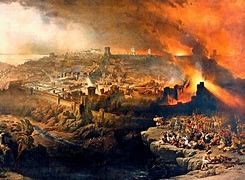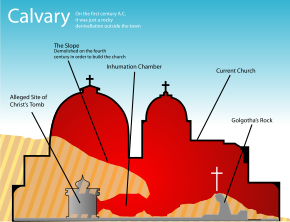PART XII: Some History of Zion, Jerusalem’s Temple Mount, and Jerusalem’s Church of the Holy Sepulchre
The church of today, including historical references regarding how it became what it is

Ten years after Herod’s death [4 BCE], Judea came under direct Roman administration. Growing anger against increased Roman suppression of Jewish life resulted in sporadic violence which escalated into a full-scale revolt in 66 CE. Superior Roman forces led by Titus were finally victorious, razing Jerusalem to the ground in 70 CE and defeating the last Jewish outpost at Masada in 73 CE.
The total destruction of Jerusalem and the Second Temple was catastrophic for the Jewish people. According to the contemporary historian Josephus Flavius, hundreds of thousands of Jews perished in the siege of Jerusalem and elsewhere in the country, and many thousands more were sold into slavery. A last brief period of Jewish sovereignty followed the revolt of Shimon Bar Kochba in 132 CE, during which Jerusalem and Judea were regained. However, given the overwhelming power of the Romans, the outcome was inevitable. Three years later, in conformity with Roman custom, Jerusalem was “plowed up with a yoke of oxen”; Judea was renamed Palaestina and Jerusalem, Aelia Capitolina.
Although the Temple had been destroyed and Jerusalem burned to the ground, the Jews and Judaism survived the encounter with Rome. The supreme legislative and judicial body, the Sanhedrin [successor of the Knesset Hagedolah] was reconvened in Yavneh in 70 CE, and later in Tiberias. Without the unifying framework of a state and the Temple, the small remaining Jewish community gradually recovered, reinforced from time to time by returning exiles. Institutional and communal life was renewed; priests were replaced by rabbis; and the synagogue became the focus of the Jewish communities, as evidenced by remnants of synagogues found at Capernaum, Korazin, Bar’am, Gamla, and elsewhere. Halakhah [Jewish religious law] served as the common bond among the Jews and was passed on from generation to generation.
Masada: The story—which came entirely from Josephus—is this: nearly 1,000 Jewish men, women and children [specifically, the casualty figures, 960 dead, two women and five who had survived the destruction of Jerusalem], occupied and fortified King Herod’s mountaintop palace complex of Masada near the Dead Sea, where they held out for three years against repeated Roman attempts to dislodge them. When the Romans finally scaled Masada and broke through its walls, they found that the defenders and their families had chosen to die by their own hands rather than be enslaved.
One of the most debated topics among Josephus scholars is the veracity of the suicide narrative at Masada he presents. One school of thought claims that it is another example of Josephus’s use of poetic license, and there was never such an occurrence. These scholars believe that Josephus’s description of the mass suicide–the only account of this episode–is fabricated, nearly whole cloth. The other side claims with equal vigor that textual and archaeological evidence prove that the mass suicide was a fact. The primary question revolves around whether Josephus’s depiction conforms to the archaeological record, although there are also many questions about the authenticity of Elazar ben Yair’s speeches. Scholars seem to agree that Josephus drew on his own literary skills to construct these speeches in conformity with the historiographical norms of the period.

Damage and destruction [614–1009]
The Constantinian sanctuary in Jerusalem [aka the Church of the Holy Sepulchre, the Basilica of the Holy Sepulchre, or simply the Holy Sepulchre, also spelled Holy Sepulch-er in American English. Eastern Christians also call it the Church of the Resurrection or Church of the Anastasis, Anastasis being Greek for Resurrection] was destroyed by a fire in May, 614, when the Sassanid Empire—the last great Persian dynasty before the rise of Islam, under Khosrau II–invaded Jerusalem and captured the True Cross. In 630, Emperor Heraclius rebuilt the church after recapturing the city.
After Jerusalem came under Islamic rule, it remained a Christian church, with the early Muslim rulers protecting the city’s Christian sites, prohibiting their destruction or use as living quarters. A story reports that the caliph Umar ibn al-Khattab visited the church and stopped to pray on the balcony; but at the time of prayer, turned away from the church and prayed outside. He feared that future generations would misinterpret this gesture, taking it as a pretext to turn the church into a mosque. Eutychius of Alexandria adds that Umar wrote a decree saying that Muslims would not inhabit this location. The building suffered severe damage from an earthquake in 746.
Early in the 9th century, another earthquake damaged the dome of the Anastasis. The damage was repaired in 810 by Christian Patriarch Thomas I. In 841, the church suffered a fire. In 935, the Christians prevented the construction of a Muslim mosque adjacent to the Church. In 938, a new fire damaged the inside of the basilica and came close to the rotunda. In 966, due to a defeat of Muslim armies in the region of Syria, a riot broke out, which was followed by reprisals. The basilica was burned again. The doors and roof were burnt, and Patriarch John VII was murdered.
On October 18, 1009, Fatimid caliph al-Hakim bi-Amr Allah ordered the complete destruction of the church as part of a more general campaign against Christian places of worship in Palestine and Egypt. The damage was extensive, with few parts of the early church remaining, and the roof of the rock-cut tomb damaged; the original shrine was destroyed. Some partial repairs followed. Christian Europe reacted with shock and expulsions of Jews, and the desecration served as one of the impetuses for later Crusades.
Reconstruction [11th century]
In wide-ranging negotiations between the Fatimids and the Byzantine Empire in 1027–1028, an agreement was reached whereby the new Caliph Ali az-Zahir (al-Hakim’s son) agreed to allow the rebuilding and redecoration of the church. The rebuilding was finally completed during the tenures of Emperor Constantine IX Monomachos and Patriarch Nicephorus of Constantinop-le in 1048. As a concession, the mosque in Constantinople was reopened and the khutba sermons were to be pronounced in az-Zahir’s name. A by-product of the agreement was the renunciation from Islam by many Christians who had been forced to convert under al-Hakim’s persecutions. In addition, the Byzantines released 5,000 Muslim prisoners and made demands for the restoration of other churches destroyed by al-Hakim and the reestablishment of a patriarch in Jerusalem. The emperor spent vast sums in an effort to restore the Church of the Holy Sepulchre after this agreement was finalized. However, total replacement was far beyond available resources. The new construction was concentrated on the rotunda and its surrounding buildings: the great basilica remained in ruins.
The rebuilt church site consisted of a court open to the sky, with five small chapels attached to it. The chapels were east of the court of resurrection. When reconstructed, the location of Christ’s tomb was under open sky, where the western wall of the great basilica had been. They commemorated scenes from the passion, such as the location of the prison of Christ and his flagellation. Control of Jerusalem–and thereby the Church of the Holy Sepulchre–continued to change hands several times between the Fatimids and the Seljuk Turks in Baghdad until the arrival of the Crusaders arrival in 1099.
The Franciscan friars renovated the Nestorian (Church of the East) in the Holy Sepulchre in 1555 during the Ottoman period. That included rebuilding the Aedicule, extending the structure to create an antechamber. A marble shrine was placed to envelop the remains of Christ’s tomb, probably to prevent pilgrims from touching the original rock or taking small pieces as souvenirs. A marble slab was placed over the limestone burial bed where Jesus’s body is believed to have lain.
After the renovation of 1555, control of the church oscillated between the Franciscans and the Orthodox, depending on which community could obtain a favorable firman [decree] from the “Sublime Porte” at any particular time, often through outright bribery. Violent clashes were not uncommon. During the Holy Week of 1757, Orthodox Christians reportedly took over some of the Franciscan-controlled church. This may have been the cause of the sultan’s firman later developed into the Status Quo of Jerusalem and Bethlehem. [The Status Quo is an understanding among religious communities with respect to nine shared religious sites in Jerusalem and Bethlehem. It is an understanding among the six religious communities with respect to nine shared religious sites in Jerusalem and Bethlehem. Other Holy Places in Israel and Palestine were not deemed subject to the Status Quo, because the authorities of one religion or community within a religion are in recognized or effective possession of them.]
A fire severely damaged the structure again in 1808, causing the dome of the Rotunda to collapse and smashing the Aedicule’s exterior decoration. The exterior was rebuilt in 1808-1810 in contemporary Ottoman Baroque style. The interior of the antechamber–now known as the Chapel of the Angel–was partly rebuilt to a square ground plan in place of the previously semicircular western end. Another decree in 1853 from the sultan solidified the existing territorial division among the communities and also solidified the Status Quo for arrangements to “remain in their present state”, requiring consensus to make even minor changes. The dome was restored by Catholics, Greeks, and Turks, in 1868, being made of iron ever since.




